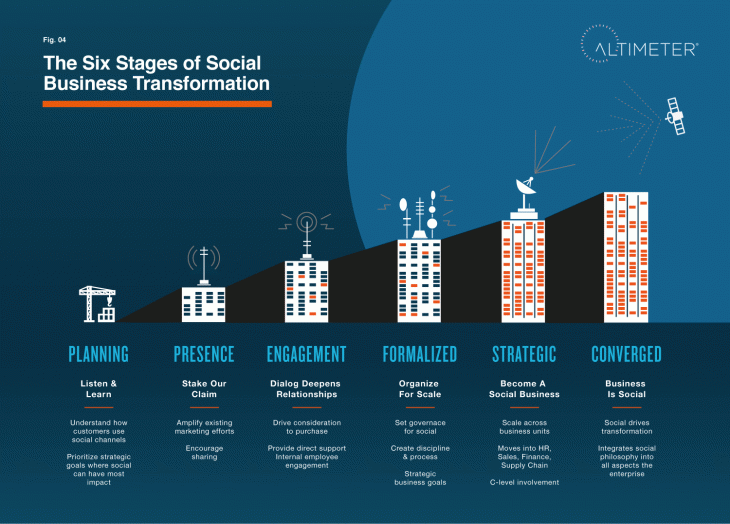As with any new technology, rates of adoption vary considerably across the marketplace, and social business is no different. A few years ago Gartner consultant Anthony Bradley outlined what he thought were the main stages of social business adoption.
- Folly – managers not only believe social business offers few benefits, but indeed they believe it detracts from what the business wants to do. It is literally a waste of time.
- Fearful – managers in this stage believe that social business is dangerous. It allows customers to bad mouth them or employees to waste time. Social exists in a highly risk averse environment here.
- Flippant – at this stage, managers can’t ignore social, but equally they don’t take it seriously either. It’s something they have to do to ‘fit in’, but they’re not convinced of its benefits.
- Formulating – we now enter more promising territory, where managers appreciate the benefits of social and also appreciate that it takes a structured approach to achieve this.
- Forging – at this stage, social leaves the marketing or IT silo it has previously resided in and is more organisation wide
- Fusing – the final stage remains sadly very rare and is when social is a fundamental part of everything the organisation does. They are truly social businesses.
As a roadmap, the 6 stages remain a pretty accurate depiction of how organisations become more social (or not). This hasn’t stopped Altimeter having a go at their own six stage model of social business transformation.
Social Business Transformation by Altimeter
The model was produced by the company heavyweights Charlene Li and Brian Solis and forms part of a report called The Evolution of Social Business: Six Stages of Social Business Transformation, which is embedded at the bottom of this post.
Unlike the Gartner model, Altimeter are at pains to point out that there is a big difference between having social media strategies and having social business ones. Whilst the former remains largely an external exercise whereby organisations use channels to engage externally, the latter is very much an integration of social into business values and behaviours.
Here are the six stages they believe organisations go through.
- Planning – this stage typically sees organisations setting the foundations for what is to come. It involves listening to stakeholders and formulating strategies based upon this.
- Presence – next organisations start to take action, creating their presence on social media.
- Engagement – now social is less of a novelty and more a way of doing business. Organisations at this stage will have a number of people involved in community building and management.
- Formalized – three steps are key to this stage. Firstly a C level sponsor is required. Secondly a social business hub is developed, and lastly core governance policies are created.
- Strategic – this stage sees social becoming more and more on the radar of senior executives, and it begins to become an organisation wide thing rather than being stuck within silos.
- Converged – here is the holy grail, the point where organisations cease to have social policies, and instead social is just how things are.
I think of the two models, I prefer the one created by Gartner as it highlights the internal difficulties organisations face in getting social taken seriously by senior executives. Where both models agree however is that this process can take many years before the organisation can regard itself as truly social.
As promised though, the full report is included below. Let me know what you think in the comments.
